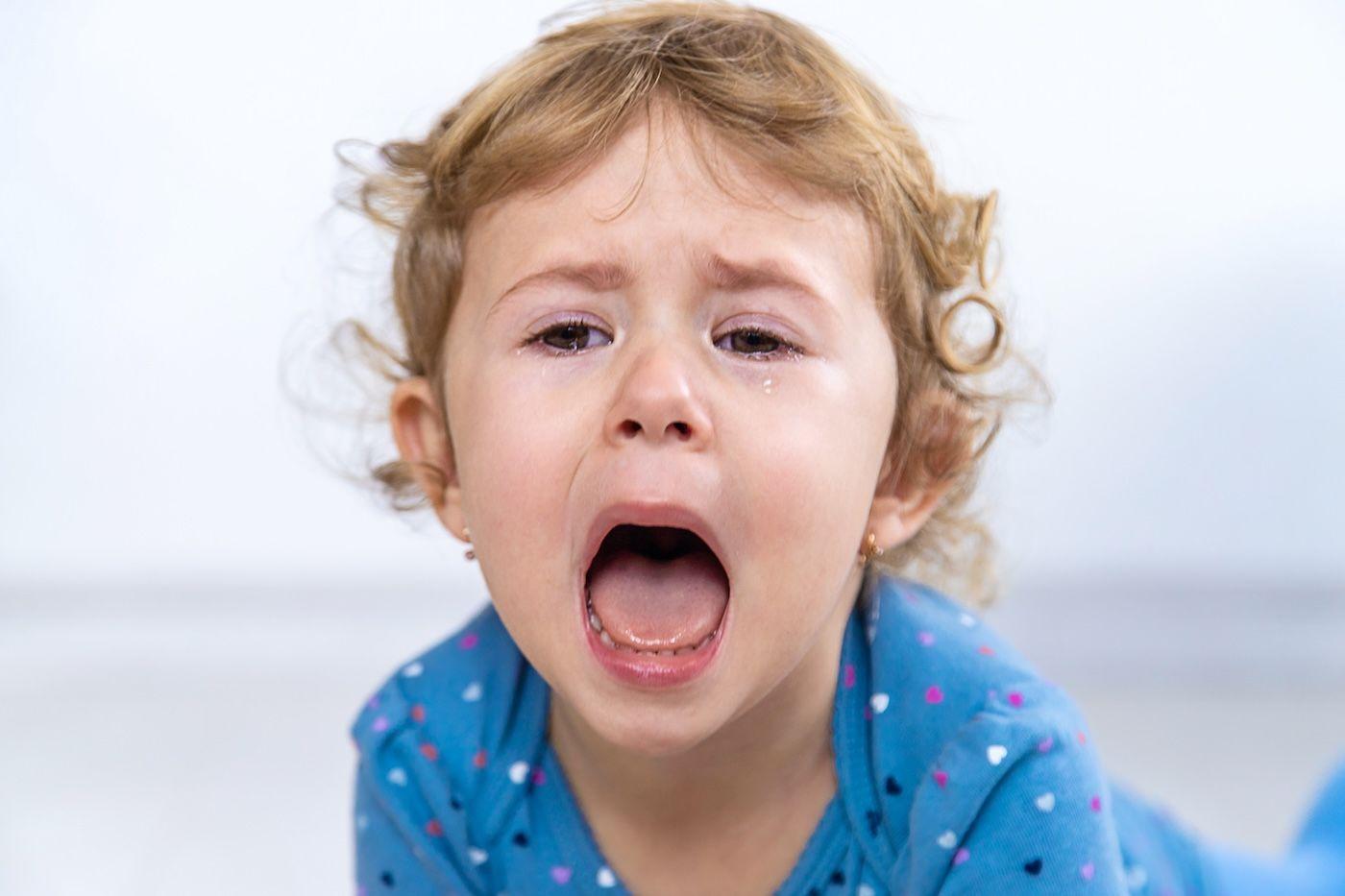TODDLER
When Does Discipline Begin for a Child?
When is it time to set some limits?

Written by
Dr. Harvey Karp

SHARE THIS ARTICLE
PARENT PICKS
Bestsellers
TODDLER

Written by
Dr. Harvey Karp

SHARE THIS ARTICLE
Bestsellers
Your once powerless little baby just repeatedly slapped you in the face…and giggles hysterically! Or, perhaps, your toddler swiped a cookie from the kitchen table after you very clearly said “no sweets until after dinner” or flatly refused to put on their rain boots during a downpour. What to do? How young is too young to discipline? Here’s all you need to know about disciplining your child.
My Happiest Toddler philosophy on discipline is different from what you might get from most other parenting experts. From my point of view, discipline starts with setting boundaries. By setting boundaries you’re building guardrails to guide your little one down the path of life. Because you want your child to succeed, your limits must be reasonable—and your rules should focus on behavior that needs to stop immediately. If you’re consistent, your toddler will soon go along with your demands.
Next, it’s helpful to think of yourself not as a disciplinarian, but as your child’s ambassador. Your job is to help your uncivilized toddler understand what good and bad behavior means for your family. To do that, you want to master the three key skills that the world’s best diplomats all use:
Discipline in its simplest forms can start as soon as your baby is 8 months old. You’ll know it’s time to start your discipline journey when your sweet bundle starts doing things like biting your arm or pulling off your glasses even after you say “no”…and then laughs and laughs.
Your child is not born knowing right from wrong. You need to teach them! For help, I recommend using all the techniques I outline in my book The Happiest Toddler on the Block. It’s a great guide for achieving good behavior.
Toddler behavior can be broken down into three basic categories, which I call green-light behaviors, yellow-light behaviors, and red-light behaviors. Good behaviors are green, annoying behaviors are yellow, and red-light behaviors are unacceptable and need to be stopped in their tracks. I strongly suggest reserving punishment for red-light behaviors. (Psst: That means just because a behavior is annoying, doesn’t make it worthy of a consequence!) Red-light behaviors fall into three buckets:
All these behaviors demand swift action, often with a “take charge” consequence. But stopping these bad behaviors doesn’t mean rolling up your sleeves and figuratively fighting your child! Like the world’s top ambassadors, you can stop most conflicts by establishing clear consequences in a respectful manner.
If your toddler did something dangerous (running into the street), acted out with aggression (hitting, biting, being cruel), or broke an important family rule (calling little bro a “poopy head”), consider using one of these three toddler discipline methods that truly work!
No, this is not the silent treatment, which is an unhealthy behavior that can leave your child feeling rejected and abandoned. Kind ignoring is giving your child a teensy cold shoulder to nudge them back to cooperation.
Age: All toddlers
When to use it: This type of ignoring should never be used when your child is frightened, hurt, or genuinely sad. Only use kind ignoring when you feel your child is being unreasonable and stubborn. The best time to use kind ignoring is when your little one is bringing the drama, like when a stubborn behavior continues simply because your child has an audience (even if it’s just you).
How it works: Toddlers crave your attention, so ignoring them—kindly—is indeed a consequence. To do that, first, connect with respect, which means acknowledging your child’s feelings with my Fast-Food Rule (repeat back what your toddler said before offering your own input) and Toddler-ese (mimic your toddler’s speaking style using short phrases, repetition, and mirroring about one-third of their emotion). Then, clearly state your “no.” For example, say your tot started to screech whenever they wanted attention instead of using their words. Try, “You want book! But no screech! Ouch! Daddy’s ears hurt! Find your nice voice and use your words and I’ll come right back.”
Then walk to the other side of the room (or even sit nearby), but do not look at your toddler. Instead, act busy (not mad, just disinterested) for 20 seconds or so. As soon as your tyke stops breaking the rule, return with loving attention. Finally, offer your explanation and reassurance. (“Nice voice! Thank you for using your words. I love the way you asked for what you wanted. Let’s read!”)
Time out is a classic discipline tactic. It’s not a sign of failure—yours or your child’s. Toddlers are supposed to push the limits—and your buttons! But we need to be ready to give clear signals when they push too far. Time outs train toddlers to take your words seriously—and to heed your warning before catastrophe occurs.
Age: 1 year+
When to use it: Use time outs when you need your child to learn that they must stop when you say “Stop.” After all, toddlerhood is the most dangerous period of childhood, and you need your child to listen to your warnings...especially when it comes to their safety.
How it works: If your child is doing something potentially dangerous or breaking a household rule, give one last warning in a serious tone with a disapproving frown, and again, connect with respect. Here’s an example: Say your 2-year-old is having a meltdown at the table because you won’t let them play with the sugar bowl. You clap your hands three to four times, hard and fast. Next, your scowl and make a deep, rumbling growl and shake your head. Once you have your tot’s attention say, “Mad. Mad. Jamie’s mad at Daddy. He’s mad, mad, mad! Jamie wants the sugar, now! But…no sugar! No sugar!”
Next, count to three. Wait one to two seconds between each number and count on your fingers, so your toddler can hear and see you at the same time. Ask your child if they want a time out for continuing X behavior. It’ll go something like this: “Jamie says, ‘Sugar, now!’ but Daddy says, ‘No way.’ Does Jamie want a time out to get calm again? One…two…three…
The phrasing is important here, because you want your child to learn that a time out is something that they are doing to themselves, not something you do to them. (A time out is always a choice!) Then, go ahead and give the time out, but only if your child does not stop the behavior.
Calmly lead your tot to “the time-out place,” like a chair or a corner of the living room, and say something like, “Come with me so you can get calm again. You are on a time out for X minutes.” Do not worry about making your young toddler stay put! In the beginning, you just want them to understand that ignoring rules will lead to a moment of isolation. For older kids, you’ll want to set a timer and you may need to confine them to a playpen or their room. As a general rule, a time out should last one minute per year of age. (Got a 2 year old? Shoot for a 2-minute time out.) When time is up—and your child’s fit is over—ask your child if they’re calm and ready to come back.
Once your calmed-down tot is back in the mix, DON’T immediately talk about the time out! Instead, right after a time out, you want to reconnect with your child and offer forgiveness—another skill you want to teach your tot! Later in the day, you can revisit what happened, use my gossiping technique—or even create your own bedtime story to reinforce your message.
If time out is like going to jail, giving a fine is like getting a ticket! It’s a “take charge” consequence that targets your toddler’s growing love of freedom and ownership.
Age: 2 years+ (Especially good for toddlers 3 years old and up)
When to use it: If your child repeatedly breaks an important rule.
How it works: Simple! Take away an object or a valued privilege. It’s key to make the punishment related to the misconduct. In other words, if your bub defies you by playing basketball in the house, remove the ball for a while. (Penalties that connect the punishment to the misbehavior are also called logical consequences.) When you take away a privilege or an object, tell your child you know how much they want it, but what they are doing is not okay. For example, if your 3-year-old keeps tossing crackers to the dog and won’t stop, take the crackers, and say, “You like feeding Fluffy crackers, but crackers are for people, NOT dogs. Mama said, ‘Stop, no, no, no!’ but you didn’t listen to Mama’s words, so… bye-bye crackers. No crackers for dogs. Now you can go play.”
Don’t confuse “discipline” with yelling or spanking! Those actions do not curb misbehavior. Instead, they teach your child that it’s okay for big people to be mean to children. Yelling and spanking also increases the likelihood your child will continue to act out. The worst part? Research shows that yelling and spanking actually change the structure of a child’s brain. I do not support either practice.
Hitting children teaches them that it is okay for big people to hit little people, and that it is okay to vent anger through violence. I know there will be times when your toddler will make you really angry, but learning Toddler-ese can truly help. As can venting your anger by clapping and growling. Remember, when you’re angry, clap, don’t slap!
Hitting is an act of aggression, which falls into the category of red-light behaviors that need to be stopped in their tracks. Hitting requires swift action with a take-charge consequence—either a time-out or a fine, depending on your child and their age. For example, a fine might look like taking away a toy that provoked a hitting-fueled sibling squabble, or it might be taking away the person that your tyke is walloping. (“Mad, mad! Aera’s so mad at Mommy that she wants to hit! But hitting hurts Mama! Mommy is going to take a break from playing for a minute while Aera calms down.”)
After your child misbehaves, you may be tempted to press them for an apology. While it’s fine to ask, it’s wise not to insist on one. Leaning on your tot for a “sorry” only invites a power struggle! And believe me, you want to avoid battles you can’t win—and forcing your tot to apologize can be impossible if they dig in their heels.
Disclaimer: The information on our site is NOT medical advice for any specific person or condition. It is only meant as general information. If you have any medical questions and concerns about your child or yourself, please contact your health provider. Breastmilk is the best source of nutrition for babies. It is important that, in preparation for and during breastfeeding, mothers eat a healthy, balanced diet. Combined breast- and bottle-feeding in the first weeks of life may reduce the supply of a mother's breastmilk and reversing the decision not to breastfeed is difficult. If you do decide to use infant formula, you should follow instructions carefully.